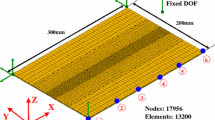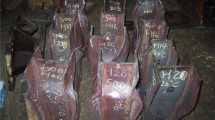Abstract
The underlying mechanisms associated with welding-induced buckling distortions are investigated using finite element procedures. Unlike stable type of welding-induced distortions which can be adequately captured by performing a thermo-plasticity simulation of actual welding procedures, local buckling distortions in welded structures are of an unstable type, which requires the use of appropriate buckling analysis procedures incorporating welding-induced residual stress state. With the underlying mechanisms in buckling distortions being established, two effective mitigation techniques were presented. One is trailing heat sink and the other is in-process synchronized rolling techniques. Detailed finite element simulations were performed to demonstrate how some of the important process parameters can be established in effectively reducing or eliminating the buckling distortions. The proposed techniques were also validated by laboratory welding trials. The underlying principles and potential applications of the distortion mitigation techniques are also discussed in light of the detailed finite element simulation results.
















Similar content being viewed by others
References
K. Masubuchi, Research Activities Examine Residual Stress and Distortion in Welded Structures, Weld. J., 1991, 70(12), p 41–47
A.K. Dhingral and C.L. Murphy, Numerical Simulation of Welding-Induced Distortion in Thin-Walled Structures, Sci. Technol. Weld. Join., 2005, 10(5), p 528–536
Y. Ueda, K. Nakacho, and T. Shimizu, Improvement of Residual Stresses of Circumferential Joint of Pipe by Heat-Sink Welding, J. Press. Vessel Technol., 1986, 108, p 14–23
P. Dong, J.K. Hong, and P. Rogers, Analysis of Residual Stresses in Al-Li Alloy Repair Welds and Mitigation Techniques, Weld. J., 1998, 77(11), p 439s–445s
P. Dong, Residual Stresses and Distortions in Welded Structures: What We Know Today and Beyond, Keynote Lecture, Proceedings of 6th International Conference on Trends in Welding Research. S.A. David, T. DebRoy, J.C. Lippold, H.B. Smartt, and J.M Vitek, Ed., ASM International, 2002, p 815–825
Y.P. Yang, P. Dong, F.W. Brust, J. Zhang, and Z. Cao, Numerical Prediction of Welding-Induced Buckling Distortion and Buckling Mechanisms, Adv. Comput. Eng. Sci., 2000, 2, p 1906–1912
Y. Yang, R. Dull, C. Conrardy, N. Porter, P. Dong, and T.D. Huang, Transient Thermal Tensioning and Numerical Modeling of Thin Steel Ship Panel Structures, J. Ship Prod., 2008, 24(1), p 37–49
M.V. Deo, P. Michaleris, and J. Sun, Prediction of Buckling Distortions of Welded Structures, Sci. Technol. Weld. Join., 2003, 8(1), p 55–61
P. Michaleris and X. Sun, Finite Element Analysis of Thermal Tensioning Techniques Mitigating Weld Buckling Distortion, Weld. J., 1997, 76(11), p 451s–457s
M.V. Deo and P. Michaleris, Mitigation of Welding Induced Buckling Distortion Using Transient Thermal Tensioning, Sci. Technol. Weld. Join., 2003, 8(1), p 49–54
E.M. Van der Aa, M.J.M. Hermans, and I.M. Richardson, Conceptual Model for Stress and Strain Development During Welding With Trailing Heat Sink, Sci. Technol. Weld. Join., 2006, 11(4), p 488–495
J. Li, Q. Guan, Y.W. Shi, and D.L. Guo, Stress and Distortion Mitigation Technique for Welding Titanium Alloy Thin Sheet, Sci. Technol. Weld. Join., 2004, 9(5), p 451–458
D.G. Richards, P.B. Prangnell, P.J. Withersl, S.W. Williams, T. Nagy, and S. Morgan, Efficacy of Active Cooling for Controlling Residual Stresses in Friction Stir Welds, Sci. Technol. Weld. Join., 2010, 15(2), p 156–165
Q. Guan, C.X. Zhang, and D.L. Guo, Dynamic Control of Welding Distortion by Moving Spot Heat Sink, Weld. World, 1994, 33(4), p 308–312
Y.I. Bural, Y.P. Romanchuk, A.A. Kazimirov, and V.P. Morgun, Selection of the Optimum Fields for preheating Plates Before Welding, Avt. Svarka, 1979, 5, p 5–9
Y.P. Yang, P. Dong, X. Tian, and J. Zhang: Prevention of Welding Hot Cracking of High Strength Aluminum Alloy by Mechanical Rolling, Proceeding of 5th International Conference on Trends in Welding Research. S.A. David, J.A. Johnson, H.B. Smartt, T. Debroy, J.M. Vitek, Eds., ASM International and American Welding Society, 1998, p 700-709
J. Altenkirch, A. Steuwer, P.J. Withers, S.W. Williams, M. Poad, and S.W. Wen, Residual Stress Engineering in Friction Stir Welds by Roller Tensioning, Sci. Technol. Weld. Join., 2009, 14(2), p 185–192
D. Xu, X.S. Liu, P. Wang, J.G. Yang, and H.Y. Fang, New Technique to Control Welding Buckling Distortion and Residual Stress With Noncontact Electromagnetic Impact, Sci. Technol. Weld. Join., 2009, 14(8), p 753–759
S.T. Timoshenko, Theory of Elastic Stability, 2nd ed., McGraw-Hill, New York, 1961
Y.P. Yang, P. Dong, J. Zhang, and X. Tian, A Hot-Cracking Mitigation Technique for Welding High Strength Aluminum Alloy Sheets, Weld. J., 2000, 79(1), p 9s–17s
Y.P. Yang, F.W. Brust, Z. Cao, J. Zhang, J.K. Hong, A. Fisher, R. Broman, and R. Thakkar, Modeling Tool Development of Weld Process for Thin Plate Automotive Application. International Conference on Computer Engineering and Science. S.N. Atluri and F.W. Brust, Eds., Tech Science Press, 2000, p 1989-1905
J. Zhang, P. Dong, F.W. Brust, Composite Shell Element Model for Residual Stress analysis of Multi-Pass Welds. Transaction of the 14th international Conference on Structural Mechanics in Reactor Technology, Vol 1, M. Livolant Ed., The International Association for Structural Mechanics in Reactor Technology, 1997, p 335–344
ASM International, Metals Handbook, 1990, 1, p 195–197
A.G. Rose-Innes, Low Temperature Technique, Vol 140, D. Van Nostrand Company, Inc, Princeton, 1965
Author information
Authors and Affiliations
Corresponding author
Rights and permissions
About this article
Cite this article
Yang, Y.P., Dong, P. Buckling Distortions and Mitigation Techniques for Thin-Section Structures. J. of Materi Eng and Perform 21, 153–160 (2012). https://doi.org/10.1007/s11665-011-9928-x
Received:
Revised:
Published:
Issue Date:
DOI: https://doi.org/10.1007/s11665-011-9928-x




